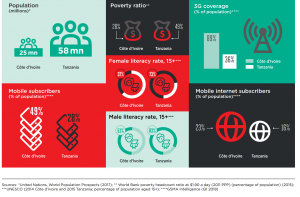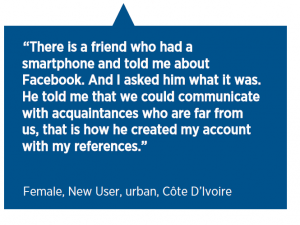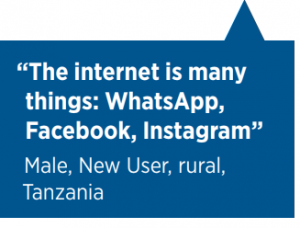The importance of tackling the mobile internet ‘usage gap’
At the end of 1997, there were just 70 million internet users globally. Within two decades, thanks in no small part to the rapid growth in mobile networks, this had grown to 3.6 billion. [1] While this means internet use has spread faster than any technology in human history, it also highlights the fact that 4 billion people remain unconnected, nearly all of whom are in developing markets. The mission of the GSMA Connected Society programme is to work with our operator members and others to help address this, increasing access to and use of mobile internet and all the benefits that it can deliver.
Of the 4 billion people that are currently offline, 1 billion are not covered by mobile broadband networks. [2] However, three times that amount live in areas with network coverage, but don’t currently use internet. [3]
In order to better understand why this is the case, last year (in conjunction with the GSMA Connected Women programme) we conducted research in four South Asian markets. [4] The findings from this research provided critical insights on the current barriers to uptake in these markets and the potential triggers for mobile internet adoption and use.
Given the success of this research, we wanted to explore the same questions in an African context, opting to focus on two countries on either side of the continent, both experiencing challenges in both mobile internet adoption and usage: Côte d’Ivoire and Tanzania.
Figure 1: Country Snapshots of Côte d’Ivoire and Tanzania
Understanding how to trigger mobile internet adoption in Cote d’Ivoire and Tanzania
Our ultimate aim with the research was to understand how mobile operators and others in the mobile ecosystem can help trigger adoption and use of mobile internet among those currently in a position to begin using it. To do this, we went out and spoke to two groups of people: those living within 3G coverage who owned a mobile phone, had basic literacy, and were not ‘rejecters’ of the internet. We labelled this group ‘Potential Adopters’. Potential Adopters were contrasted with a group of recent mobile internet adopters with the same socio-demographic background to help understand what initially triggered their use and then sustained it over time (termed ‘New Users’).
We chose a qualitative methodology for the research in order to explore people’s deeper rational and emotional barriers and motivations. [5] We visited urban, peri-urban and – in Tanzania- rural locations. To complement this, for the report, we also drew on relevant data from the GSMA Consumer Survey 2017 and the 2018 Mobile Connectivity Index.
Our six key findings
1. Potential Adopters and New Users have a positive perception of the internet, but see it as a ‘double-edged sword’ that carries risks as well as opportunities. In both Côte d’Ivoire and Tanzania, New Users and Potential Adopters view the internet as a positive phenomenon they would like to be a part of. However, it is also seen as a double-edged sword that has both clear benefits (e.g. connection to the wider world) and potential risks (e.g. online scams or harassment).
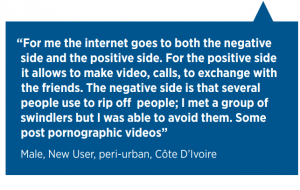
2. For Potential Adopters, the three greatest barriers to mobile internet adoption are: lack of awareness of the benefits of mobile internet use, the cost of smartphones, and low levels of digital literacy.
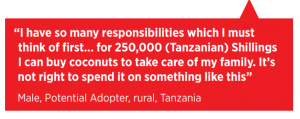
3. Female Potential Adopters face more challenges adopting mobile internet than men, mainly due to existing social norms rather than being explicitly prevented from using it.
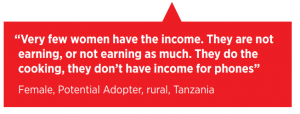
4. New Users required ingenuity and perseverance to adopt mobile internet, and enabling social circles are critical. Because mobile internet adoption is still nascent or limited in both countries, many Potential Adopters do not have people within their social circle who can support them.
5. New Users understand the relevance of mobile internet as it fulfils one (or more) of four needs: connection, entertainment, keeping up to date (and feeling part of the modern world) and personal development and productivity. While the first two areas are well understood, many are still unaware of how mobile internet could help to address their personal progression or productivity needs. Once understood, however, these are highly valued use cases.
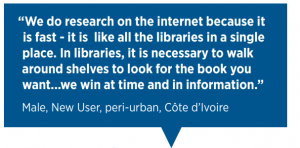
6. New Users’ mobile internet use is often shallow and restricted to a few key applications. New Users must grapple with a range of issues, including the affordability of devices and data, network issues, and access to electricity. While they have found ‘workarounds’, there are still challenges and many end up being stuck on ‘app islands’, unable to utilise the full potential of mobile internet.
These findings are explored in greater depth in the full report, along with strategic recommendations to help operators (and others) to address the highlighted issues, including examples of how these could be implemented. Find out more by downloading the reports:
We also conducted similar research in Burkina Faso. Results will be available on this blog in the coming months.
[1] IDC (1997) and ITU (2017)
[2] For example, we recently launched our Mobile Coverage Maps, a tool that gives a hyperlocal view of where mobile coverage gaps are in Nigeria and Tanzania (with more countries to follow over the coming months)
[3] All data GSMA Intelligence, Q4 2017
[4] Four South Asian markets were included in the research: Bangladesh, India, Pakistan, and Sri Lanka. Read more in: Triggering mobile internet use among men and women in South Asia
[5] This included focus group discussions, in-depth interviews, written and photographic pre-tasking (where respondents were asked to keep a three-day diary of their mobile phone use), home visits with ordinary users, and interviews with local retailers.


